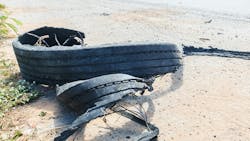Living in the mid-Atlantic, I get all four seasons—sometimes in the same week. The winters are definitely milder than what I remember from my days in the Chicago area, but spring, summer, and fall are pretty much the same. Spring is a favorite because I love seeing the trees and flowers come to life. The warm days and cool nights are ideal for working and playing outside. I’m also a big fan of fall because the colors paint such a beautiful picture of the landscape with similar temperatures.
Summer is a different story. I love it because it means pool season is in full swing. We belong to a local swim club, and you will probably find me there almost every weekend, accomplishing absolutely nothing.
For truck tires, however, summer is prime gator season. When a tire is operated in an underinflated condition, the buildup of internal heat starts to break down the bonds between the belts and the body plies. The combination of heat, speed, and centrifugal force causes the belt package and tread to become separated from the casing, leaving a strip of steel and rubber on the road that is often referred to as a gator. There’s a strong likelihood that someone’s vehicle will sustain some damage when they end up in a traffic lane.
See also: Tire monitoring solutions for preventing costly fleet breakdowns
The findings of studies that analyze roadside tire debris contradict what most people think about the strips of tread rubber on the side of the road. The myth is that gators are failed retreads. While the data reflects a balance between new tire debris and retreads, public opinion (drivers included) often blames retreading as the culprit. Again, the data shows that most roadside tire debris is from underinflation and/or overloading. Being a retread or new tire is inconsequential. Most gators are not caused by defects in tires or improper retreading practices. Lack of inflation pressure is the main perpetrator.
A truck tire’s enemy is heat. When a tire flexes, it generates mechanical heat. As long as the flexing is within the operational limits of the casing, a truck tire can operate for hours without problems. If the flexing exceeds those limits, bad things are on the horizon.
During the winter, spring, and fall months, cooler ambient temperatures can mitigate some excess heat that builds up when inflation pressures are on the borderline for the load. In the summer, higher temperatures add gas to the fire, so borderline underinflation leads to damaging heat levels much faster.
Excessive speed is another factor that causes heat buildup that leads to gators. Most truck tires are rated at 75 mph unless designated otherwise. When the vehicle speed exceeds the tire's limit, the additional flexing results in excessive internal heat, which has the same effect as underinflation. Throw in a little underinflation, and it’s a recipe for a roadside failure.
Preventing gators is as easy as ensuring tires are properly inflated and operated within limitations for speed and load. Drivers are the biggest deterrent for gators if they use an air gauge instead of a tire thumper or boot-o-meter to check tire pressure. Automatic tire inflation systems are another effective tool for ensuring proper inflation in trailer tires. There are relatively new inflators for drive tires that attach to the hub and can help prevent underinflation. Tire pressure monitoring systems warn drivers of potential inflation issues so they can address them before they result in belt separations.
Inflation pressure maintenance should be a year-round priority, but summer is the time when it is the most critical. There is some margin of error when ambient temperatures are lower, but that margin erases quickly during pool season. It requires a coordinated effort between maintenance personnel and drivers to make sure inflation pressures are correct while limitations for speed and load are followed at all times.
Failure leads to failure, which means a gator that should have been prevented ends up with another unnecessary roadside breakdown and repair bill.
About the Author
Kevin Rohlwing
Kevin Rohlwing is the SVP of training for the Tire Industry Association. He has more than 40 years of experience in the tire industry and has created programs to help train more than 180,000 technicians.
